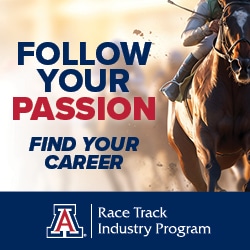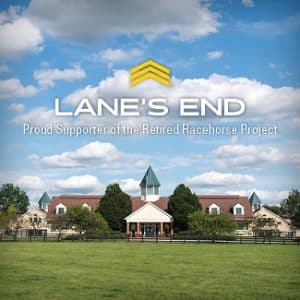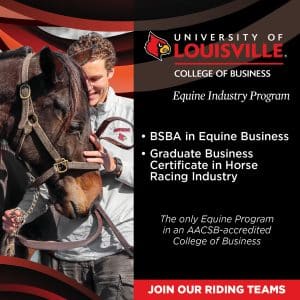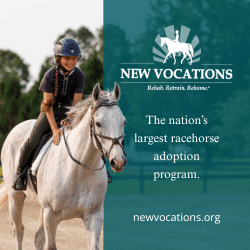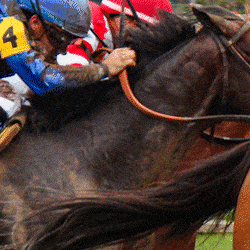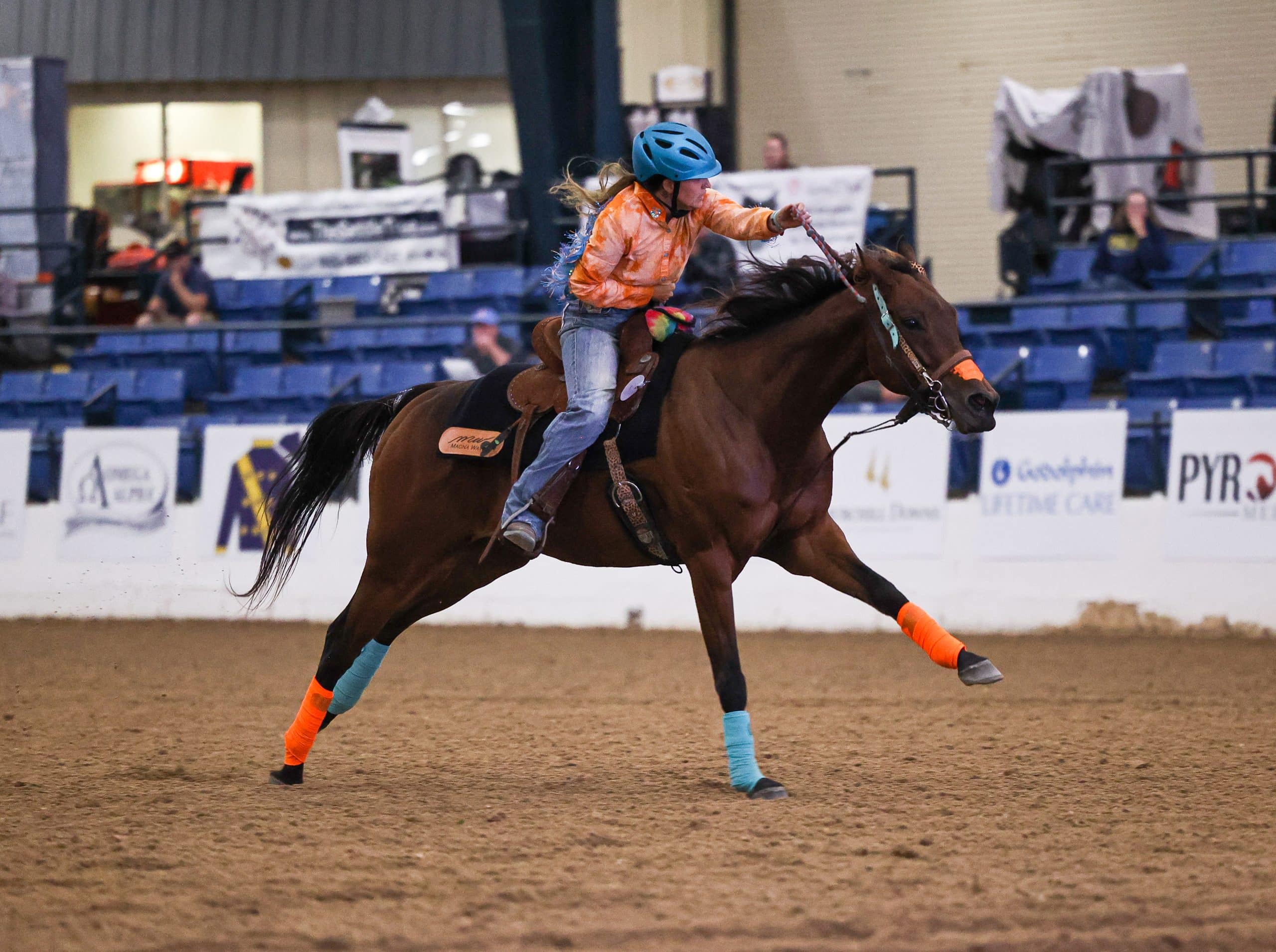
Liz Howell and 2019 Makeover graduate Whiskey Terms have been successful on the local semipro rodeo circuit. Photo by CanterClix
When a young Kate Keeney sent her little bay mare blasting through the cloverleaf pattern at several of the largest National Barrel Horse Association races on the East Coast, no one knew Hope to Burn was a Thoroughbred. No one knew that in her six years on the track, the daughter of Hopeville, out of Beat the Heat, by Talc, had lit the board 36 times — seven being wins — in 86 starts. No one knew she’d won $78,151 before she ever started her barrel racing career. They just knew she and Keeney were a team to beat.
Barrel racing statistics are nowhere near as complete as those for racing, but EquiStat, a leading database in the Western performance horse industry, tabulated earnings of $62,089 in Hope to Burn’s name from 2003 to 2012.
Hard Turns and Work Ethic
While Thoroughbreds have always found a place in this predominantly Quarter Horse sport, through organizations like the Retired Racehorse Project their numbers are growing. In the world of professional rodeo, horses like Amber Moore’s Nasmune (Eishin Masamune — Silence N Lucidity, Nasgame), Brianne Hansen’s Highly Tessible (Chancery Court — High Lil’ Lady, Highland Park) and Lindsay Jensen’s Arghazi (Ghazi — Argenti, Minneapple) are money earners.
Liz Howell, of Jacksonville, Florida, is hoping to join their ranks with her 2019 Thoroughbred Makeover graduate, Whiskey Terms (Connecting Terms — My Doctor Knows, My Friend Max).
“I’ve been trying to hit a lot of the local, semipro rodeos until I can buy my pro card,” says Howell. To be eligible to compete in Women’s Professional Rodeo Association events, riders must first earn $1,000 on a permit before purchasing a card to enter the bigger and richer rodeos. “During the Lake City (Florida) pro rodeo, they have a locals’ only race, and he won that in 2021. I was extremely shocked because it was only his second rodeo. I remember thinking this was crazy! Maybe we really can do this!”
Howell adopted Whiskey Terms (aka “Little John”) in 2018.
“He’s on the smaller size, he’s only 15.1 and he’s compact,” Howell says. “They were trying to make him into a dressage horse. When I rode him for the first time, I could just tell he was looking for a job. Even now, I feel like he wants something to do. His work ethic is really great. When you get on him, he’s all business.”
Little John’s experiences on the track made hauling and the seasoning process easier because he had seen so much as a racehorse. Horses without that experience must learn their jobs while accepting distractions such as people in the stands, banners along the fence and other horses in the warmup pen.
“He acclimated to barrel racing really well,” says Howell. “We took it really slow because all he knew to do was run, run, run, run, but it wasn’t like starting a horse from scratch. All we had to do was polish some things.”
Once Little John figured out how to maintain his momentum throughout the pattern, he was able to make turns that led people to think he was a Quarter Horse rather than a Thoroughbred.
“He turns really hard, but it was just getting him to realize that you’ve got to slow down to do that,” Howell says with a laugh. Rate — the collection process on the approach to a barrel — is what makes or breaks a winning run. Not enough rate means a slower time, and too much can add a five-second penalty for knocking over a barrel. “People have this misconception that Thoroughbreds can’t turn. If he’s set up properly, he really does set his hind end in the ground and turn.”
After taking third place in Barrel Racing at the Makeover, Howell focused on open shows (barrel racing jackpots) near her home and some of the larger races in Georgia. She and Little John were third at the Thoroughbred Incentive Program (T.I.P.) Championships in 2021 and won the event in 2022. This year, her friend Rowan Hughes will be riding Little John at the T.I.P. Championships running concurrently with the Makeover.
“It’s crazy when I look back at how far he’s come and how great he is now,” says Howell. “Rodeos have always been my thing, and if we can master the open shows then we can rodeo. It’s what I’ve been working for.”
OTTBs on the High-School Rodeo Scene

Megan Montgomery won the second round of the 2021 T.I.P. barrel championships with her 2020 Makeover mount, David’s Slingshot. Photo by CanterClix
After finishing second as a junior rider at the 2018 Thoroughbred Makeover, Megan Montgomery, of Newfield, New Jersey, took her “heart horse” Little Red Rodeo (Textbook — I’m A Stinker, To Freedom) to high school rodeos.
“I did pole bending on her too,” she says. A speed event like barrel racing, pole bending involves three hairpin turns and a slalom-style pattern through poles positioned 21 feet apart. “She was a very nice pole horse. She had 21- and 22-second runs. She showed me how amazing Thoroughbreds can be for Western riding and barrel racing.”
Montgomery wasn’t the only one riding an OTTB at high school rodeos in New Jersey and Pennsylvania.
“Thanks to groups like Turning for Home and Another Spin, a lot of high school competitors in South Jersey are running Thoroughbreds, and they’re winning,” she says. “Girl Crush, who goes by Sharron now, and Addyson Szawronski are winning left and right in high school rodeo. We had Dover’s Point (an OTTB her mother, Danielle, trained) run in Wyoming last year at the National High School Rodeo Finals.”
After high school Montgomery continued to run “Red” at various jackpots as well as retrain other Thoroughbreds. The mare’s barrel racing career ended after a very successful Mega Makeover in 2021. Red won the first round of the T.I.P. Championship, and Montgomery’s 2020 Makeover mount, David’s Slingshot, (Trappe Shot — Page Dancer, Hennessy) won the second round.
“David’s Slingshot, who had two years less training than Red, outran her with the fastest time of the whole weekend,” she recalls.
While David’s Slingshot is winning with a youth rider in Pennsylvania, Red is on to her third career as a broodmare. Montgomery hopes Red’s offspring excel on the track as well as the barrel racing arena.
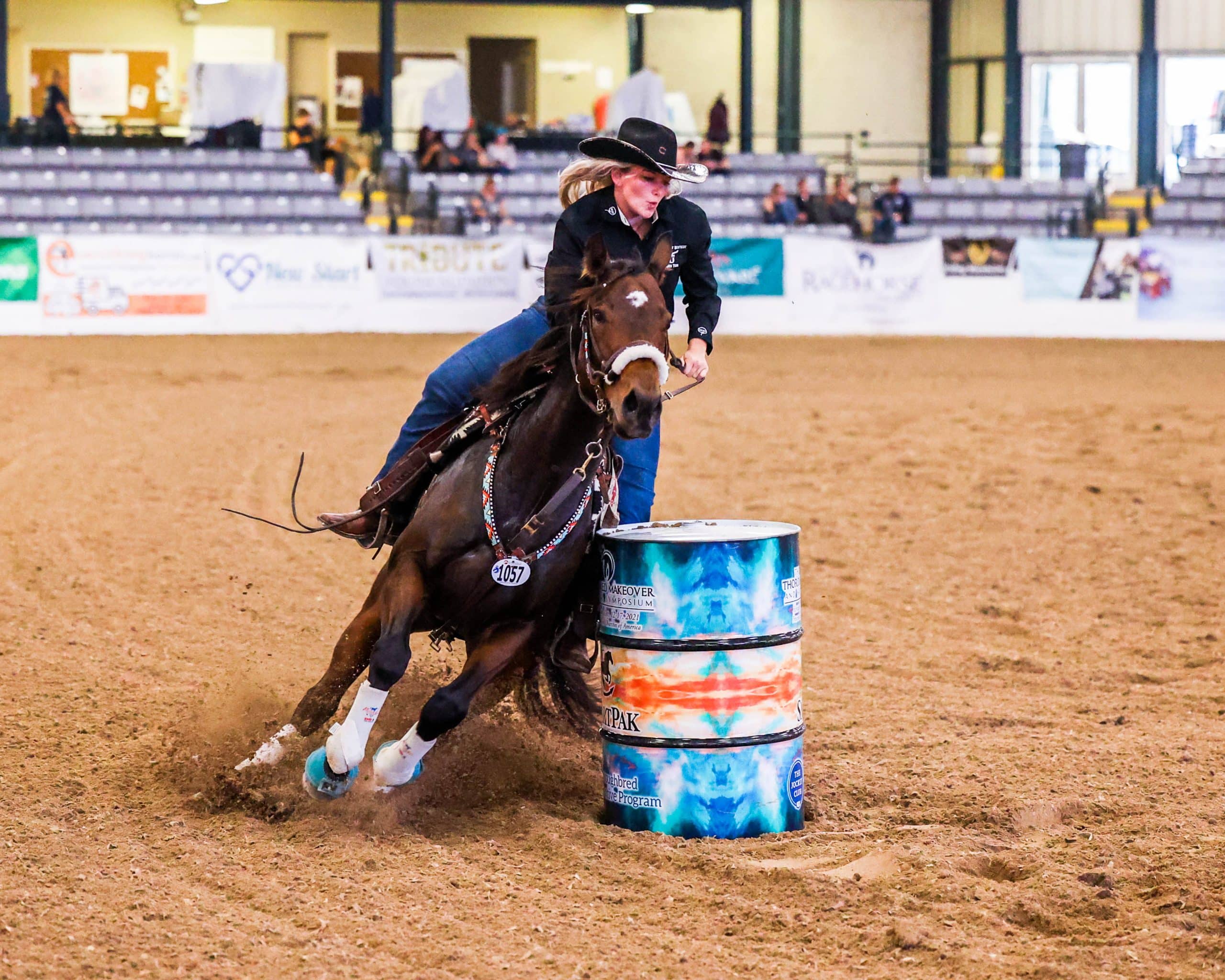
David’s Slingshot posted the fastest time of the weekend during the 2021 T.I.P. championships. Photo by CanterClix
The Divisional Format: Accessibility for All
Barrel racing, in general, became much more user-friendly in the early 1990s with the development of the divisional format, or “D” system. Loosely based on the bracket system used in drag racing, the winning time sets three, four or five predetermined timing increments, typically split by a half or full second, for prizes and payouts. The first division, or 1D, has the fastest times, down to a 4D or 5D that’s typically two seconds back of the winning time.
This format, which most nonrodeo events throughout the world utilize, made barrel racing more accessible to all levels of riders and all breeds of horses, just like it did for Hope to Burn and Keeney, who earned all their money in the 1D and 2D. It has also allowed horses and riders who are just learning the sport a chance to be competitive.
Local divisional races have been key components of the Thoroughbred Makeover seasoning process for most contestants, including Jessica Frederick, of Cynthiana, Kentucky.
In 2020 Frederick’s Czraina Maria (Risque Remarque — Sky Lady, Sky Mesa) won the reserve title in the 4D at the National Barrel Horse Association’s Kentucky State Championships while prepping for the Makeover, which was canceled due to COVID. At the Mega Makeover in 2021, she won the barrel racing championship for the 2020 division and topped both rounds of the T.I.P. Championships in the 2D. Last year she won the second round of the T.I.P. Championships and finished reserve in the 1D average.
“She’s my girl, and she’ll never leave me,” says Frederick, who also bumped up divisions at her local races.
Frederick also has Ten Plagues (American Pharoah — Corey’s Holiday, Harlan’s Holiday) moving up the divisions. “Corey” was the 2021 Thoroughbred Makeover Reserve Champion in Barrel Racing and ran third in the T.I.P. 3D average. Once the mare is further along in her barrel racing career, she’ll move on to a youth rider.
“(Thoroughbreds) are so smart, and they have such a work ethic on them,” says Frederick. “They’ll do anything you want if you just give them a chance.”
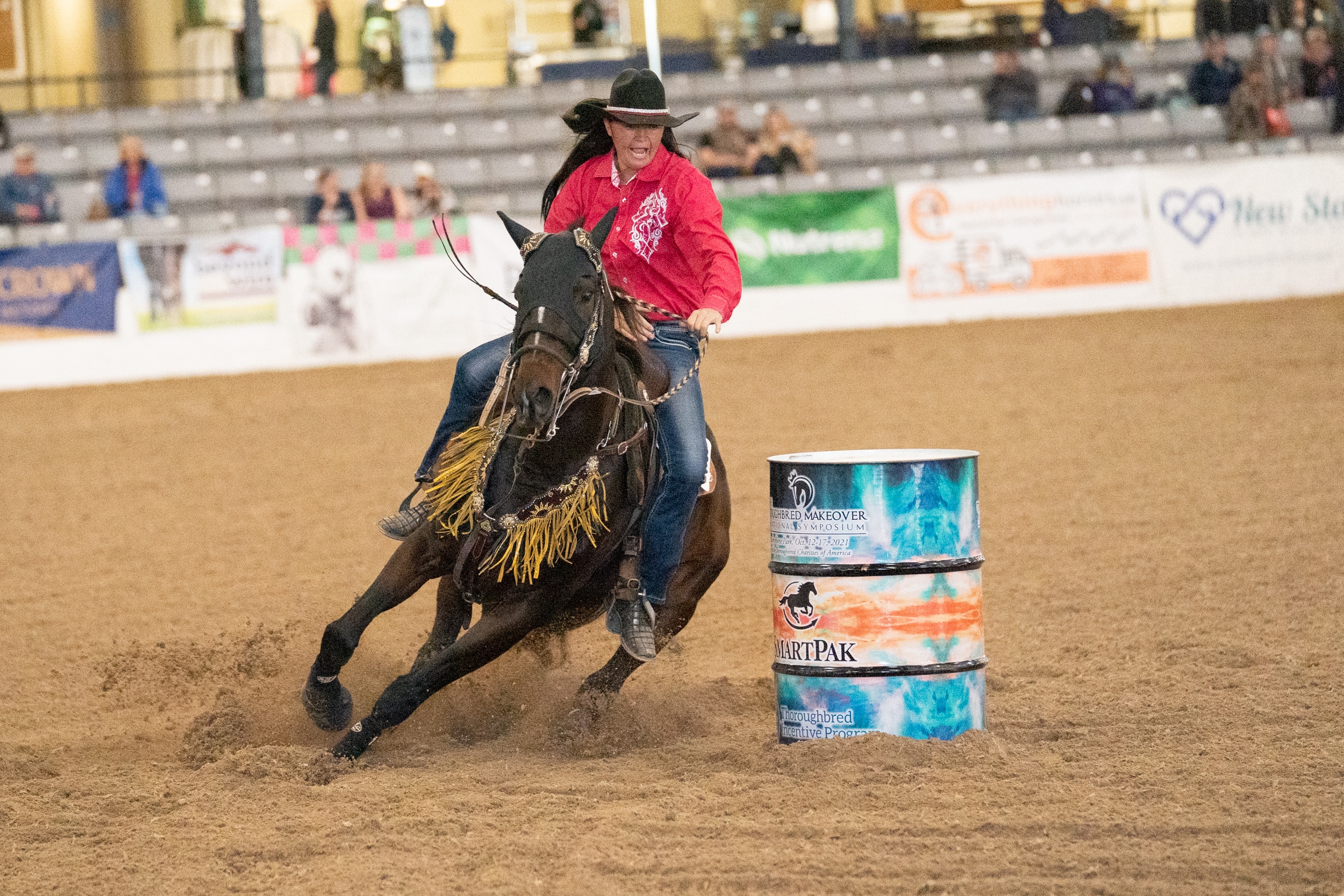
At the Mega Makeover in 2021, Jessica Frederick and Czraina Maria won the Barrel Racing championship for the 2020 division and topped both rounds of the T.I.P. Championship in the 2D. Photo by CanterClix
Tanya Randall is an award-winning equine journalist and avid barrel racer. After graduating from Texas A&M University, Randall has spent the past 25 years extensively covering the sport of barrel racing, from winning bloodlines to horse health care and everything between. In her spare time she enjoys raising and training horses with her husband Matt, an equine veterinarian, and son, Colton.

